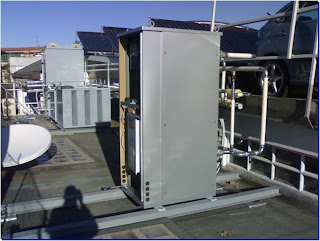 |
| Main Equipments Required for Solar Air Conditioning |
As you can see from the above image and from the previous post how solar air conditioning works, there are certain things you need to account for to see if your building will be able to accommodate the solar air conditioning equipment such as:
Roof Area Required for Panel Installation on Roof:
Harvesting solar energy via solar thermal panels that is used to feed hot water to the absorption chiller requires a lot of space on the roof or open space. This is not like thermal panels for water heating where 40 Deg C will be sufficient for a shower. The absorption chiller requires input temperature of around 80 Deg C and above for it to operate efficiently and you would get a 6 Deg C chilled water output.
If you are living in a hot climate, you may be able to harvest enough heat during the day time to operate the chiller without backup. However, when the chiller starts to operate, your hot water temperate will drop down tremendously in a very short time. Therefore, a huge area may be required for thermal panels.
 |
| Solar Thermal Panel Array for Solar Air Conditioning |
Roughly speaking, cooling 1,400 Square meters of building space requires around 380 square meters of open space. That is around 30% only for solar thermal panels for 10 Hours operation. What about the remaining hours of the day? You either need to have a free source of heat or rely on gas, electric or solid fuel boiler.
Area Required for the Cooling Tower:
The cooling tower that controls the Lithium Bromide Chiller’s temperature needs space close to the Lithium Bromide chiller. You must allocate a space on the roof or in an open area.
 |
| Example of a Cooling Tower |
In addition, you must have a constant supply of warm water around 35 Deg C otherwise the chiller won’t operate properly.
In addition, the cooling tower requires electrical power for the cooling fans to bring the water temperature down. The electrical power consumption is less than 10% of the power consumed by conventional chillers.
Area Required for Absorption chiller:
The absorption chiller is not large in size and has a low Coefficient of Performance (COP) 0.5-0.7. The Absorber chiller can be installed externally (on the roof for example).
 |
| Size of an Absorption Chiller |
Area for Hot Water Storage Tank:
Since we have no control over the weather, clouds may represent a problem on a cloudy day. Therefore, it is necessary to store hot water in a storage tank similar to the one used for water heaters.
 |
| Solar Water Heater Storage Tanks |
The hot water storage tank required could be above 5,000 liters. Is your building ready to accommodate such a large tank?
Absorption Chillers Maintenance:
The absorption chiller requires periodic maintenance. After the first installation, the installing company will need to visit your site after the first week, then after a month, the after three months. Then a periodic six months visit would be required.
Lithium Bromide may require replacement once every five years depending on its condition. Furthermore, Li-Br is not a really environmentally friendly substance. Disposal of Li-Br is expensive and special handling is required by specialist companies. Furthermore, special handling is required for transportation.
Finally, even though the sun provides us with a free source of energy that can be transformed into cold or hot water during the day, solar air conditioning is still a new emerging technology that is under testing with few installations worldwide. This technology may be good for areas with average temperatures of 35 Deg C during the day. However, for colder or hotter areas it would require special arrangements to overcome these barriers.
No comments:
Post a Comment